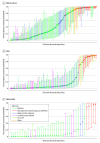Association of Patient and Site-of-Care Characteristics With Reproductive Carrier Screening Timing in a Large Integrated Health System
- PMID: 36346628
- PMCID: PMC9644263
- DOI: 10.1001/jamanetworkopen.2022.40829
Association of Patient and Site-of-Care Characteristics With Reproductive Carrier Screening Timing in a Large Integrated Health System
Abstract
Importance: Reproductive genetic carrier screening can be performed prior to or during pregnancy to assess a reproductive couple's risk of having a child with a recessively inherited disorder. Although professional societies endorse preconception screening as preferable to prenatal screening to allow for greater reproductive choice, implementation of preconception screening is challenging.
Objective: To determine how carrier screening timing varies by multilevel factors associated with health care delivery including patient, clinician, and location across a large integrated health care system.
Design, setting, and participants: This cross-sectional study used a mixed-methods approach including (1) quantitative analysis of multilevel factors associated with the timing of reproductive carrier screening and (2) qualitative analyses of data from interviews conducted with clinicians ordering carrier screenings. The setting was the Mass General Brigham, a large integrated health care system in the greater Boston, Massachusetts area. Participants included adult female patients who completed reproductive carrier screening performed by Myriad Women's Health between October 1, 2018, to September 30, 2019.
Exposures: Site of care (ordering clinical location and hospital affiliate), ordering clinician specialty, and patient characteristics, including age at date of test collection, self-reported race and ethnicity, primary insurance payor, and number of comorbidities.
Main outcomes and measures: The primary outcome was the timing of carrier screening (preconception vs prenatal). A series of 4 multilevel logistic regression models were fitted to measure the relative contribution of site, clinician, and patient-level factors on the timing of screening. Interviews with ordering clinicians (N = 9) were analyzed using a framework approach to explore barriers to preconception screening.
Results: Among 6509 adult female patients who completed carrier screenings, 770 (12%) were Asian, 352 (5%) were Hispanic, 640 (10%) were non-Hispanic Black, 3844 (59%) were non-Hispanic White, 858 (13%) were other or multiple races and ethnicities, and 2611 (40%) were aged 31 to 35 years; 4701 (63%) had prenatal screening and 2438 (37%) had preconception screening; screenings were ordered by 161 distinct clinicians across 32 clinical locations affiliated with 4 hospitals. In model 1, adjusted for hospital (fixed effect), clinic and clinician (random effects), 49% of the variability in timing was associated with clinician-level effects (intraclass correlation coefficient [ICC], 0.49) and 28% was associated with clinic-level effects (ICC, 0.28). Clinician specialty explained the greatest amount of variation in screening timing. Interviewed clinicians (N = 9) supported preconception screening but cited several barriers to offering population-based preconception screening.
Conclusions and relevance: In this cross-sectional study, multilevel factors were associated with carrier screening timing. These findings suggest that increasing access to preconception screening may involve engaging specific medical specialties.
Conflict of interest statement
Figures

References
-
- Gregg AR, Simpson JL. Genetic screening and counseling, an issue of obstetrics and gynecology clinics - e-book. Elsevier Health Sciences. Published 2010. Accessed September 29, 2022. https://play.google.com/store/books/details?id=S4kRx74eXMQC
Publication types
MeSH terms
Grants and funding
LinkOut - more resources
Full Text Sources
Medical

